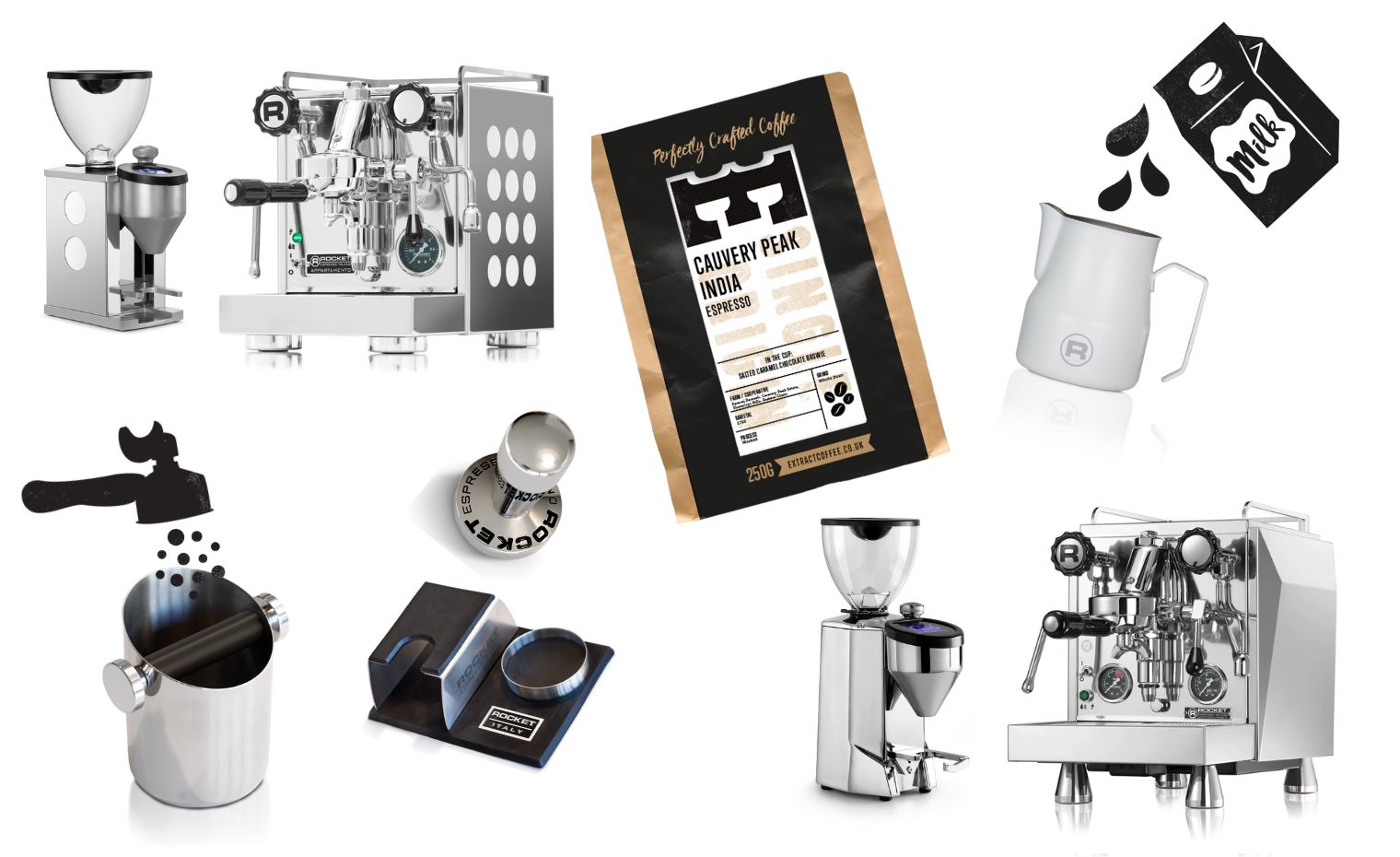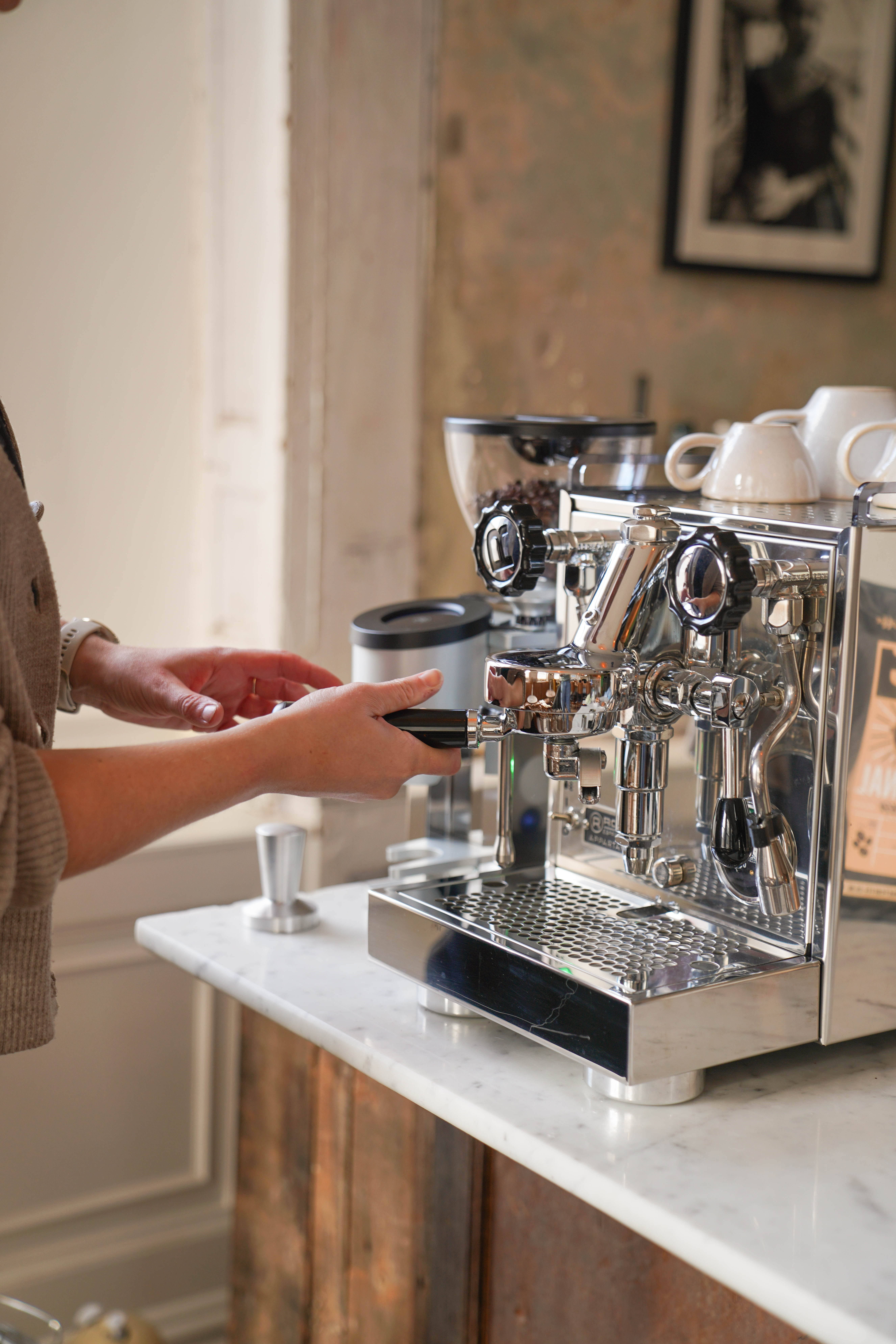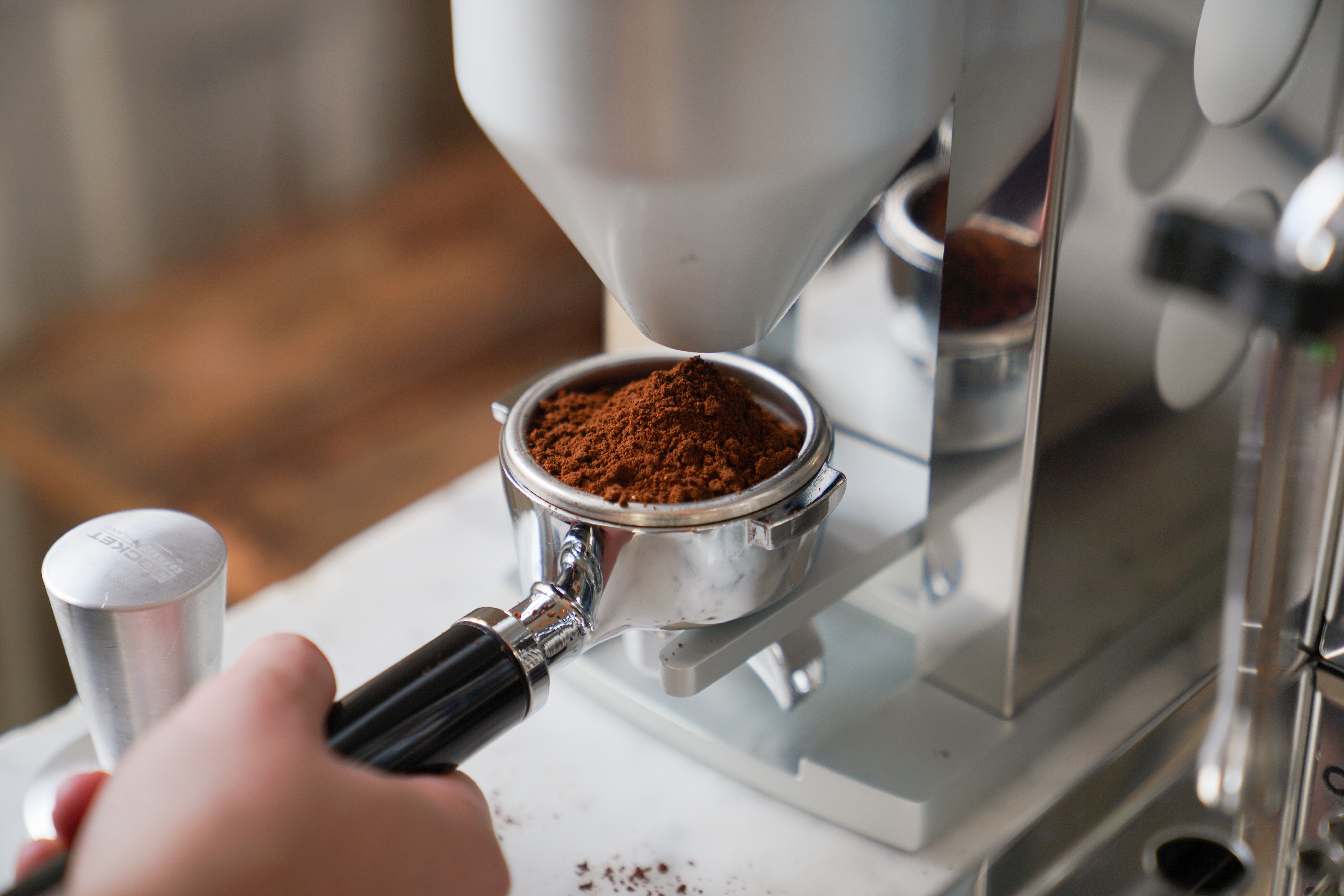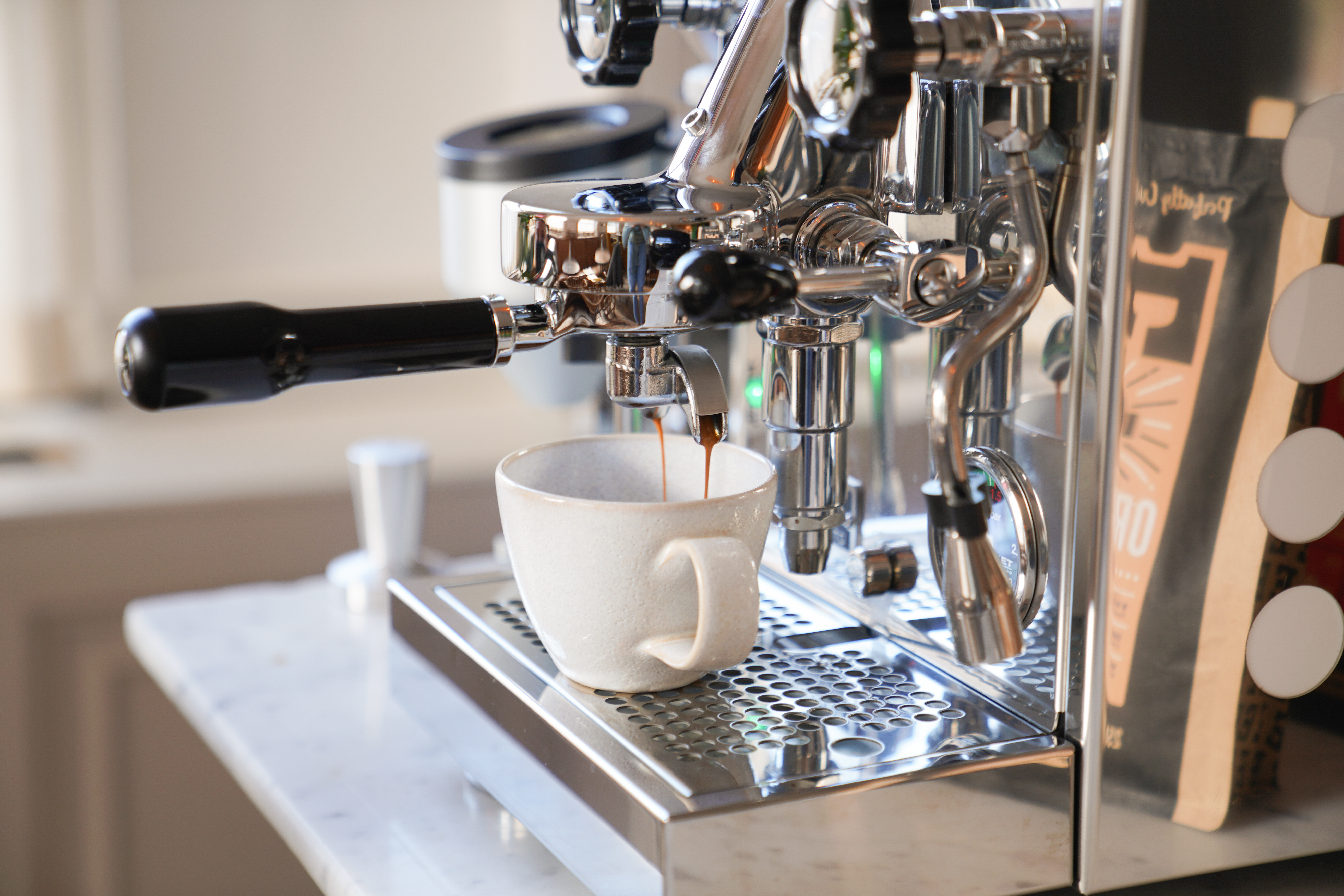
Espresso coffee brew guide
Let’s set the scene…
We're bringing our professional expertise to the comfort of your kitchen at home. In this brew guide we explain how to pull the perfect shot of espresso using a domestic espresso machine.
Every espresso machine is slightly different and works in its own way, so in this guide we share some professional barista tips which home baristas can apply in the comfort of your own kitchen.
If you're looking for some tips to help you research and choose a new espresso machine, or advice on the best espresso machine to buy, check out our espresso machine buyers guide.
What actually is espresso?

Espresso is a short, strong coffee which is made by passing hot, highly pressurised water through finely ground, compacted coffee grounds. It's made using an espresso machine.
Espresso forms the base of nearly all barista-style drinks. Different amounts of steamed and textured milk are added to a double shot of espresso to create a latte, flat white or cappuccino.
Espresso is made using finely ground coffee - this is also known as espresso ground.
The roast profiles for these coffees are more developed (one of the reasons they work so well with milk and alt milks) and this is called an espresso roast.
What do you need to make good espresso at home?
- Finely ground coffee
- Espresso machine
- Coffee Scales
- Coffee Tamper
- Coffee Tamp mat
- Coffee knock box (somewhere to put your spent coffee grinds)
- If you use whole-beans, you also need a coffee grinder.
If you don't have a coffee grinder at home, make sure you buy coffee which is pre-ground for espresso. This should be a fine grind. When buying coffee online from Extract, just choose the portafilter or espresso icon in grind settings.

Step by step espresso brew guide
1. PRE-HEAT YOUR COFFEE MACHINE
Switch on your machine to pre-heat.
Something like the Rocket Appartamento or Rocket Giotto machine can take up to 15 minutes to get up to temperature.
Your espresso machine should be heated up to temperature before you start making espresso. This ensures a more even extraction of the coffee whilst brewing.
If your coffee machine is under-temperature, your coffee could be under-extracted or unevenly extracted, resulting in a poor-tasting espresso. We talk more about troubleshooting problems with your espresso, later in this guide.
2. REMOVE YOUR PORTAFILTER & RINSE
Remove the portafilter from the grouphead.
Rinse a small amount of water through the shower screen.
This cleans away any oils from previous shots of coffee and warms the group head if the machine has only recently been switched on.

3. KNOCK OUT & WIPE CLEAN
Knock old coffee out of the portafilter into your knock box. Something like the Rocket Knock Box is a really handy countertop solution for this.
Wipe the basket clean using a microfibre cloth. Make sure no coffee from previous brews remains.
4. GRIND & WEIGH: 18G
Weigh 18g of finely ground coffee into the portafilter basket.
We find the best way of doing this is to weight your portafilter, tare the scales to 0, then weigh the portafilter and coffee together.
You can use regular kitchen scales for this however a set of coffee scales will come in really handy here to help you get more precise.
In the roastery, we use Felicita Arc and Felicita Parallel scales. The smaller Felicita Incline scales are a good home option.
You should have 17.8-18.2g.
Gently tap the side of the basket with your finger until the coffee is flat and even.
Your coffee should be a fine grind. Roughly the consistency of table sale. Not as fine as flour. Our favourite domestic coffee grinders for espresso are:
- Rocket Espresso Faustino coffee grinder
- Rocket Espresso Fausto coffee grinder
- Mazzer X La Marzocco Lux-D coffee grinder

5. TAMP: FIRMLY & EVENLY
Push down on the coffee in the basket using your tamp.
Try to make sure you tamp as flat as you can. This helps your coffee extract more evenly.
A common mistake is too much pressure when tamping. This compacts the coffee in the portafilter, making it hard for water to run through and resulting in over-extracted coffee (bitter, yuck.)
Be firm, don't hulk it.
Don't bang or tap your portafilter after tamping. This creates water channels in your coffee and results in an uneven extraction.
6. WIPE & INSERT YOUR PORTAFILTER
Wipe coffee from the ridge of your brew basket, lugs & pour spouts.
Insert the portafilter into the group head on your coffee machine.
THE GOLDEN ESPRESSO RATIO: 1:2 IN 25-30 SECONDS
We recommend a brew ratio of 1:2.
So, if you weigh 18g of coffee into your portafilter, you want to brew a double shot of 36ml espresso.
Some machines, like the Rocket Giotto, have a built in shot timer and will pour a set amount of water for each shot, then tell you how long that takes to pour.
On coffee machines like the Rocket Appartamento or the La Marzocco Linea Mini, the espresso shots need timing manually. So, you need to measure how much espresso pours out to know how long each shot takes.
An espresso shot glass is a handy tool to make this easier; alternatively, mark a 36ml water line on to a regular shot glass.
7. PULL YOUR SHOT:

Place your cup below the portafilter and start pouring your espresso by pressing the button or lever on your machine.
- On the Rocket machines this is putting the lever to position 2.
- On the Linea Mini, this is sliding the lever across.
- On a Sage of DeLonghi machine this is through the double shot button or on the touchscreen.
If your machine does not have a built in shot timer, you need to start your timer now.
You can get magnetic timers to stick to the side of your machine, but we tend to use our phone.
When you have the required amount of coffee (36ml), stop the pour on your machine (unless this happens automatically).
Your double shot of espresso should take 25-30 seconds to pour.
If the time is longer or shorter, you need to troubleshoot. (scroll down to troubleshooting!)
TROUBLESHOOTING ESPRESSO AT HOME
Espresso not tasting as good as you hoped? In this section we're going to talk about troubleshooting. What might have gone wrong with your home espresso and, how you can fix it.
UNDER EXTRACTION: TELL TALE SIGNS: LESS THAN 25 SECONDS OR SOUR-TASTING
If your double shot espresso has come through in less than 25 seconds, chances are your coffee is under extracted.
The water has run through the portafilter too quickly; the coffee hasn’t had enough contact time with the water to extract all the flavour.
The first step to diagnosing a problem with your coffee is to taste it.
Under extracted coffee tastes sour. If your coffee is under extracting here are a few things you can do:
- Adjust your dose. Do you have 17.8g-18.2g in your portafilter?
- Adjust your grind. Try making your coffee grinds finer.
- Tamp harder: Do you need to tamp more firmly?
- Check your temperature. Is your machine up to temperature? Cooler temperatures can result in under extraction.
OVER EXTRACTION: TELL TALE SIGN: OVER 25 SECONDS OR BITTER TASTING
If your double shot espresso has come through in more than 25 seconds, chances are your coffee is over extracted.
The water has run through the portafilter too slowly; the coffee has had too much contact time with the water and too much flavour has been extracted.
Over extracted coffee tastes bitter and burnt. It is the taste of bad coffee.
If your coffee is over-extracting, here are a few things you can do:
- Adjust your dose. Do you have 17.8g-18.2g in your portafilter?
- Adjust your grind. Try making your coffee grinds coarser.
- Tamp more gently: Are you tamping too hard?
EXTRACT COFFEE’S PRO TIPS FOR BETTER ESPRESSO AT HOME
- Freshly ground: Buy whole beans and grind the coffee you need as you need it using a coffee grinder. Fresher is better when it comes to flavour.
- Be precise: Paying attention to the weight and coarseness of your coffee grinds, the timing and volume of your espresso shot will result in more consistent results each time.
- Water matters: Filtered water will help some of the more interesting, delicate flavour notes in your coffee really stand out. Filtered water also helps keep your machine in better condition and prevents the build up of limescale.
- Pre-heat: Pre-heat your grouphead, cup and portafilter to help get a more even extraction.
- Keep it clean: Cleaner machines make better tasting coffee. Make sure you clean your coffee machine regularly using espresso machine cleaner.

HOME BARISTA ESPRESSO FAQs
Here are some of the questions we get asked most frequently at our Home Barista Workshops and in our professional barista training.
What coffee should I use for espresso?
When shopping for coffee from Extract Coffee Roasters, you'll notice the coffees have one of two different roast profiles: Espresso Roast or Filter Roast.
Espresso roast means the coffee has been roasted for longer, allowing the sugars to caramelise and resulting in a darker roast.
These coffees have been roasted with espresso machines in mind. Espresso roasts can withstand the higher pressure in brewing to produce the short, strong shot of coffee you’re looking for. Something like Extract Original is a great place to start and is a versatile and consistent coffee to brew with.
If you add milk or plant based milks to your espresso - to make a flat white or a latte, for example; an espresso roast coffee stands up to the sweetness and creaminess of the milk.
If you like longer, very milky drinks, you might want to try one of our darkest roast coffees - like Cast Iron. This coffee is designed to be paired with milk and to cut through long milky drinks.
If you enjoy your coffee as a double shot, a long black or an americano, or with just a dash of milk like a macchiato; you could try one of our lighter-roast single origin espressos. These coffees have a slightly lighter roast profile and more complex flavours which can be appreciated if you take your coffee black.
What grind should I use for espresso?
Your coffee should be a fine grind for espresso. If you buy whole beans and grind them yourself, aim to grind your coffee a little finer than table salt, not quite as fine as flour.
If you buy coffee pre-ground on the Extract website, select the portafilter icon to choose coffee ground for espresso.
It can be tricky to get a home grinder which grinds finely enough for espresso. The Rocket Fausto, Rocket Faustino Grinder and Mazzer Lux-D grinders are on the pricier end of home grinders, but a worthy investment and some of the best we’ve found.
How can I make my espresso more consistent?
Practice and precision are the key to making consistently tasty coffee shot after shot.
Weigh your coffee with the most accurate scales you can to make sure your dose is correct (17.8 to 18.2g), a set of coffee scales really will make a difference here.
Time your shot accurately to keep it within the 25-30 second window.
Make sure your machine is up to temperature before you start to brew.
Keep your machine clean and well maintained.
Decaf clogs up my machine. Why is this?
The Decaffeination process makes the beans more brittle. This means that when ground and subjected to the high pressures of espresso brewing, they can become too fine and clog up the machines.
In commercial grinders and commercial machines in cafes, this is less of a problem as these machines are high spec, finely tuned and designed to overcome these problems.
For domestic machines, finely ground decaf coffee it can result in your espresso machine getting clogged up.
Some top tips are:
- Adjust your grind. Try making your coffee grinds slightly coarser.
- Tamp more gently.
What equipment should I use?
There is so much coffee equipment to choose from if you're looking to make great tasting coffee at home. Below we've listed some of our recommendations.
This isn't an exhaustive list of domestic brew equipment, but a selection of tried and tested pieces which members of the Extract team use themselves, or home-versions of the professional equipment that we use in our roastery.
Scales - we like the Felicita Incline coffee scales. They’re super precise, allowing you to weigh with accuracy of 0.1g.
Grinders - Home grinders are tricky. We find the only ones that can really grind fine enough for espresso at home are the Rocket Fausto and Faustinofelic grinders. Also the Mazzer Lux D from La Marzocco.
Espresso Machines - There are loads out there depending on your budget. We sell the Rocket Appartamento, Rocket Giotto and La Marzocco Linea Mini. These are high end premium domestic machines, but are the very best that we’ve found for making barista-quality espresso at home.
Tamper, knock box and tamp mat. The Rocket machines and La Marzocco Linea Mini all come with a barista box which includes a tamper. The Rocket Espresso tamper can also be purchased here.
We like the Rocket Espresso Knock Box to get rid of spent coffee (biscuits or pucks) from your portafilters and the Rocket Espresso Tamping Station to protect your worktops and keep your home barista accessories together.
Espresso Machine cleaner: It’s important to keep your espresso machine clean and in good condition. The Rocket machines and Linea Mini come with espresso machine cleaner and cleaning brushes in their barista box.
You can also buy espresso machine cleaner from Extract Coffee Roasters online.
ALL THAT READING LEFT YOU THIRSTY?
Well done for making it to the end. It's a long one, but we hope you've found our espresso guide useful.
If you'd like to browse our latest coffees online, check out our webshop using the button below, if you'd like more coffee tips, browse through more of our Extract Coffee Roasters brew guides.
Until next time coffee lovers.
